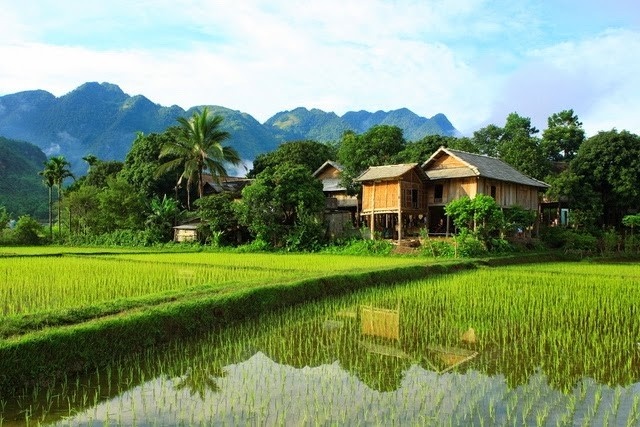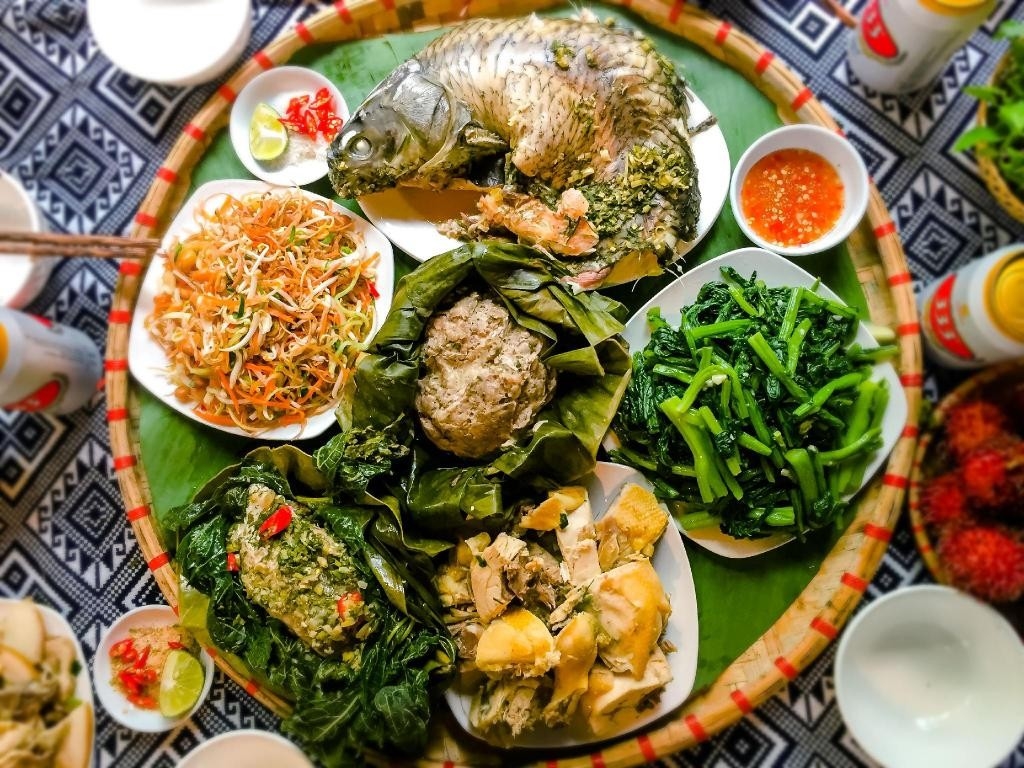Cập nhật: 01-01-1970 12:00:00 | Blogs about Vietnam | Lượt xem: 2043
Nested in a charming valley surrounded by green hills, Mai Chau Vietnam is a perfect getaway that captures any nature lover’s heart. From vast rice fields, cool mountain breezes to lovely stilt houses and delectable home-cooked food, this land is a great place to soak up Vietnam’s rural culture and temporarily forget the hustle and bustle of everyday life
Mai Chau is a highland district located in Hoa Binh Province, about 150 km West of Hanoi. It’s home to several ethnic groups, of which the Thai people make up the majority, followed by the Muong and the H’mong. As a result, Mai Chau’s culture is a blend of these three, with Thai culture being the main element.
With stunning natural beauty and an idyllic atmosphere, the land of Mai Chau attracts a large number of tourists each year. However, it has yet to be urbanized and still perfectly retains the pristine appeal of Northwestern Vietnam.

Located at an altitude of 800 – 1000m above sea level, Mai Chau features a tropical highland climate with pleasant weather all year round. Its highest and lowest temperature is respectively 34.2°C and 13.1°C, with an average yearly temperature of 23.5°C.
You can visit Mai Chau at any time of the year, but the best times are spring (February – April) and autumn (August – October). In the spring, the blossoms bloom most gorgeously and the weather is warm and dry. Meanwhile, autumn is the harvest season and an ideal time to get lost in endless golden rice fields.
Mai Chau is still beautiful in the summer and winter. However, the summer heat and heavy rainfall aren’t easy to cope with, especially if you plan to go hiking. During winter months, the temperature drops really low and the weather is quite humid and foggy, making it hard to travel or even simply enjoy the views.
You can get from Hanoi to Mai Chau by taking public shuttle buses departing from My Dinh or Yen Nghia bus station, costs about $3 – 5 per passenger for a one-way bus trip; and the journey often lasts 3. 5 – 4 hours. However, there are no buses going directly to the villages in Mai Chau such as Lat Village, Bom Coong, etc. Then, a convenient way with low cost to travel from Hanoi to Mai Chau is taking the shuttle buses Hanoi to Mai Chau and shuttle bus Hanoi to Pu Luong.
Because the scenery is so beautiful that you might wish to stop on the way for photo taking, it’s most convenient to rent a private vehicle and drive there on your own, or book a Mai Chau tour package and let your travel agent customize a trip for you.
Adventures might rent a motorbike and traverse through the winding road to Mai Chau. It’s fun to drive on your own, but be assured that you are an expert driver.
The town of Mai Chau itself is quite small and can be easily explored by walking or cycling. Most hotels and homestays have bicycles for rent at $2 a day, some are even cost-free.
If you plan to visit surrounding areas, you can rent a scooter for $5 - $7 a day, or hire electric buggies at the cost of $15 for up to 8 passengers.
Taxis are available here but aren’t really convenient due to the narrow roads.
Mai Chau offers a variety of accommodation choices, but most visitors prefer spending the night in a homestay as it’s the best way to feel closer to nature. Most Mai Chau homestays are set in Lac Village and Pom Coong Village, which lie right next to each other, only 200m apart. Prices for one night in these villages start at $5 for one single bed in a dorm room, and $12 for a standard double room.
There are also several splendid resorts for those who like higher-class options, with Mai Chau Ecolodge, La Maison De Buoc, as the most well-known. This is an enclosed ecological site with rustic designs inspired by the Thai ethnic’s wooden houses, panoramic views of the pretty Mai Chau valley, and fun activities. Room rates here start at $83 per night.

The flat surface and captivating landscapes make Mai Chau one of the best places for cycling in Vietnam. Under good weather conditions, a cycling trip past green rice paddies and through the colorful ethnic villages will be a great way to destress and clear your mind. You can come up with your own plan, or hire a local guide to accompany you on the trails.
By visiting ethnic villages nearby like Lac and Pom Coong, you’ll be able to experience local culture to the fullest. The best pick would be sleeping over in a homestay, but if that’s not your first choice, you can still share a communal meal with the villagers, learn about their weaving tradition and listen to their stories. Especially, as night falls, visitors might be welcomed with a graceful Xoe dance – the Thai folk dance that was listed as an UNESCO’s Intangible Cultural Heritage.
Travel from 15 - 50 km from the Mai Chau Valley, and you will find untouched regions for escapes to discover the soul of Mai Châu through its most enchanting villages. From Mai Hich, you can trek to Săm Khòe and Bước, immerse yourself in the warm hospitality and rich traditions of the White Thai. Journey upward to Hang Kia – Pà Cò, famous for its spectacular cloud-hunting viewpoints and refreshing mountain climate. You can also explore the vibrant Sunday Pà Cò Market and take home handcrafted treasures. And don’t miss Thung Mài —an authentic H’Mông village where traditional crafts, spring blossoms, and cultural festivals create a truly unforgettable experience.
Located on National Highway No 6, Thung Khe Pass is a winding mountain road that local bikers love to conquer for what they call “cloud hunting”. It’s also known under the name White Rock Pass due to the snow-like appearance caused by solid limestone. At an altitude of 1000 m above sea level, the pass offers an incredible view of the whole Mai Chau valley from high above, not to mention the majestic mountains and forests of Northwest Vietnam.
Thung Khe Pass is about 24 km from Mai Chau’s center and can be reached by bus, taxi or motorbike. Chances are you have already crossed this pass on your way from Hanoi, but it’s truly worth returning if you haven’t stopped there yet.
Sited about 10 km from the town center, Mo Luong and Chieu are the two largest and most astonishingly shaped cave complexes in Mai Chau with thousands of years of age. Mo Luong Cave consists of 4 main caverns with a depth of up to 500 m, all of them boast countless layers of unique limestone stalactites formed by erosion. Meanwhile, Chieu Cave challenges explorers with its 1000-step staircase and leaves a strong impression thanks to the magnificent beauty under natural light.
You’ll need to pay a small fee to enter these caves, which is less than $1. Remember to check the weather before starting your excursion, because the paths here would be really muddy and slippery when it’s raining outside.
Go Lao Waterfall with its ravishing beauty is undoubtedly an unmissable destination during your Mai Chau trip. The waterfall is about 20 m high and divided into 3 streams, which flow down together on a steep cliff. From a distance, it looks like an interesting highlight in the middle of a lush green jungle.
This breathtaking landscape is only 12 km from Mai Chau and should be visited from July – September, when its streams are at their strongest. At the base of the waterfall, there’s also a small lake that’s perfect for swimming during hot summer days.
Not far from Go Lao Waterfall is Hoa Binh Lake, the largest man-made water reservoir in Vietnam with a capacity of about 9.45 billion m3. This gigantic lake has marvelous appeal and will be an ideal spot for a memorable boat trip, which often takes two hours and costs around $2 – 3. It’s recommended to arrange the trip via your resort/homestay in advance since most boat owners here aren’t fluent in English.
Besides renting a boat, you can also experience other water activities on Hoa Binh Lake such as kayaking, surfing or canoeing…
If you love Mai Chau, you’ll love its neighbor Pu Luong. Pu Luong is a nature reserve founded in 1999 with an area of 17,662 ha. Generally speaking, it’s quite like Mai Chau with mountain scenery, beautiful caves and waterfalls, as well as diverse ethnic cultures. However, Pu Luong is blessed with more rice terraces due to its steep terrain. For this reason, it’s an amazing place for hiking/trekking and is a bright star of various Vietnam trekking tours.
Pu Luong Nature Reserve is about 50 kilometers from Mai Chau and can be visited easily on a Mai Chau Pu Luong day trip. You can hire a local guide, or traverse the reserve on your own. Most attractions in Pu Luong are free to explore, except Kho Muong Village – which only charges about $0.5. If you want to rent a bamboo boat to sail down the rivers and the streams, the price should be around $3 for 4 – 6 guests.

Dubbed the quintessence of Northwestern Vietnam cuisine, com lam is an appetizing dish you will fall in love with. To make an authentic com lam, the cook must clean the sticky rice first, then put it in a bamboo tube with a little coconut water before roasting the whole tube on charcoal. Finally, they remove the bamboo and sprinkle some sesame seeds on it. The smell of roasted bamboo, together with the sweetness of coconut water, makes this rice dish an irresistible specialty.
Pa pinh top, which means grilled whole fish in the Thai ethnic language, is another outstanding delicacy in Northwestern Vietnam. It is made from fresh stream fish stuffed with ginger, lemongrass, herbs and especially mac khen (Indian prickly ash). As being grilled on charcoal, the fish is often clamped by bamboo sticks to better absorb spices.
Free-range chicken, or ga doi (hill chicken) like how they call it, is really popular in Vietnam’s mountain regions. As the chickens have to roam freely on the hill to seek their own food, they’re likely to have firmer meat compared to the normal industrial ones. Ga doi in Mai Chau can be prepared in different ways, most commonly roasted or boiled with lime leaves.
Mai Chau’s grilled pork stands out among others thanks to a special spice mixture that includes salt, pepper, lemongrass, ginger, galangal and mac khen... The secret to a tasty pork skewer is to not overcook it. You need to grill the skewer really slowly, until it turns to an eye-catching golden brown shade.
This bizarre dish isn’t for everyone, but it does taste lusciously. Wild bees and bamboo shoots are two typical ingredients favored among locals. In the late summer, they usually bring home large wild beehives and turn them into tasty eats, for example this one. The fatty pupae, combined with the sour taste of bamboo shoots, are something weirdly impressive.
Ruou can is a fermented rice wine indigenous to several ethnic groups in Vietnam. Its ingredients include common cereals and some kinds of forest herbs, which vary in different locations. The name ruou can literally means straw liquor, as you need to drink it via a huge bamboo “straw”. On a cold evening, sharing a jug of ruou can with local villagers will be quite an experience for sure.

Essentials Tours - 10 days 9 nights

Culture - History - 13 days 12 nights

Active & Adventure - 10 days 9 nights















